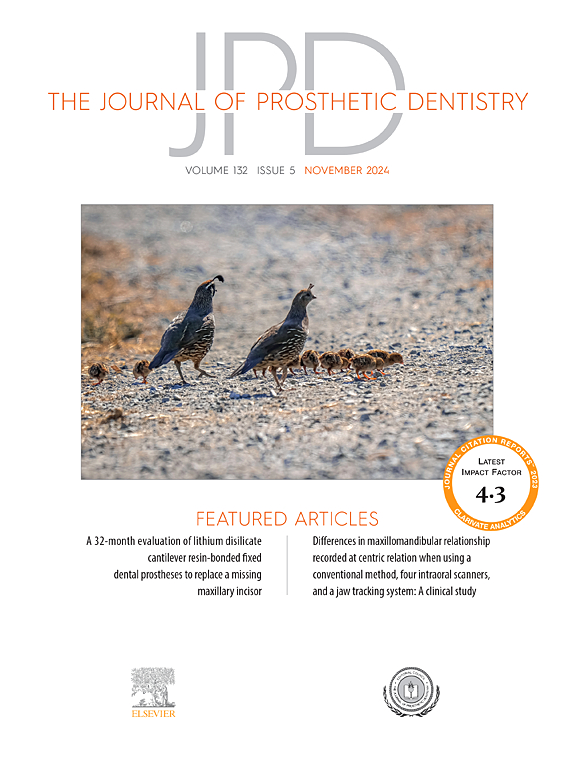氧化锆种植支撑固定全口义齿的生存分析:一项5年回顾性队列研究。
IF 4.3
2区 医学
Q1 DENTISTRY, ORAL SURGERY & MEDICINE
引用次数: 0
摘要
问题说明:目前关于氧化锆种植支撑固定全口义齿(Zir-IFCDs)中期至长期存活率的现有数据缺乏。目的:本回顾性临床研究的目的是评估zr - ifcd患者假体的存活率。材料和方法:检索奥古斯塔大学乔治亚牙科学院(DCG)的患者记录系统,以确定2015年至2022年期间由DCG研究生修复、全科住院医师和普通牙科高等教育(AEGD)项目接受zir - ifcd治疗的所有患者。更换的原因分为贴面瓷失败、框架断裂、种植体丢失、患者驱动的担忧、咬合过度磨损等。结果:符合纳入标准的牙弓67个,上颌46个,下颌骨21个。中位随访时间为8.5个月(四分位数范围为2.7至30.9个月)。67个弓中共有9个被确定为失败(4个上颌弓,5个下颌骨弓),需要更换。失败原因如下:框架骨折3例,种植体丢失2例,患者相关问题2例,贴面瓷骨折1例,未知原因1例。Zir-IFCDs的1年联合生存率(Kaplan-Meier,对数正态模型)为88.8%,5年联合生存率为72.5%。结论:基于研究结果,Zir-IFCDs的生存率低于类似研究的报道,但高于已发表的金属-丙烯酸树脂- ifcds的结果。最常见的失败原因是氧化锆框架断裂。氧化锆框架的厚度、咬合间隙、悬臂长度、咬合力和对牙列的状态可能与框架失效有关,应进一步研究。本文章由计算机程序翻译,如有差异,请以英文原文为准。
Survival analysis of zirconia implant-supported, fixed complete dentures: A 5-year retrospective cohort study
Statement of problem
Existing data on the mid-term to long-term survival rates of zirconia implant-supported, fixed complete dentures (Zir-IFCDs) are lacking.
Purpose
The purpose of this retrospective clinical study was to assess the prosthetic survival rate in patients treated with Zir-IFCDs.
Material and methods
The patient record system at the Dental College of Georgia (DCG), Augusta University was searched to identify all patients treated with Zir-IFCDs from 2015 through 2022 by the DCG graduate prosthodontic, general practice residency, and Advanced Education in General Dentistry (AEGD) programs. Reasons for replacement were grouped as failure of veneering porcelain, framework fracture, implant loss, patient-driven concerns, excessive occlusal wear, and other.
Results
A total of 67 arches were found that met the inclusion criteria, 46 maxillary and 21 mandibular. The median follow-up time was 8.5 months (interquartile range, 2.7 to 30.9 months). A total of 9 of the 67 arches were identified as having failed (4 maxillary, 5 mandibular), requiring replacement. Reasons for failure were as follows: 3 framework fractures, 2 implant losses, 2 patient-related concerns, 1 fracture of veneering porcelain, and 1 unknown. The combined survival rate (Kaplan-Meier, log-normal modeling) for Zir-IFCDs was 88.8% at 1 year and 72.5% at 5 years
Conclusions
Based on the findings, the Zir-IFCDs investigated had a survival rate lower than that reported in similar studies, though higher than published results for metal-acrylic resin-IFCDs. The most common source of failure was fracture of the zirconia framework. Thickness of the zirconia framework, interocclusal space, cantilever length, occlusal force, and status of the opposing dentition may have been associated with framework failures and should be investigated further.
求助全文
通过发布文献求助,成功后即可免费获取论文全文。
去求助
来源期刊

Journal of Prosthetic Dentistry
医学-牙科与口腔外科
CiteScore
7.00
自引率
13.00%
发文量
599
审稿时长
69 days
期刊介绍:
The Journal of Prosthetic Dentistry is the leading professional journal devoted exclusively to prosthetic and restorative dentistry. The Journal is the official publication for 24 leading U.S. international prosthodontic organizations. The monthly publication features timely, original peer-reviewed articles on the newest techniques, dental materials, and research findings. The Journal serves prosthodontists and dentists in advanced practice, and features color photos that illustrate many step-by-step procedures. The Journal of Prosthetic Dentistry is included in Index Medicus and CINAHL.
 求助内容:
求助内容: 应助结果提醒方式:
应助结果提醒方式:


